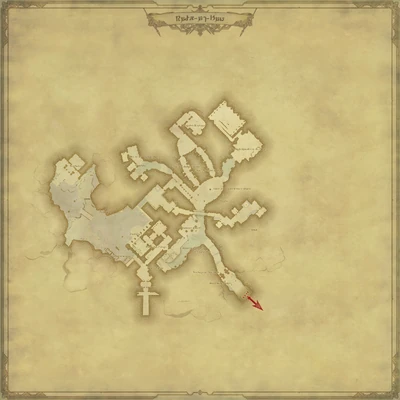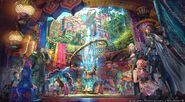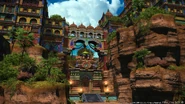
There's no gettin' off this train we on 'till we reach the end of the line.
A vast rock squats upon Thavnair, and to its stony surface clings the city of Radz-at-Han. Ye who enter here are subject to the scrutiny of gods—the gate's most watchful eye. The orb which beholdeth the truth of all things. Pass beneath its hot and piercing gaze, bearing down like a second midday sun. The fragrant haze a mixture of sweet incense and acrid smoke. The cries of merchants mingled here with lively melodies accented by dancers' feet. Travelers seduced by vivid sound and colors were once swallowed up by patchwork streets. But no such scenes to savor now. To what somber present does that divine eye bear witness?
Radz-at-Han [ˌrædz-æt-ˈhɑːn, ˌrɑːdz-] is a Near Eastern city-state on the isle of Thavnair in Final Fantasy XIV, made accessible to players in Final Fantasy XIV: Endwalker. Radz-at-Han has maintained its independence due to a non-inteference treaty with the Garlean Empire. Some believe the treaty was only formed so Garlemald can obtain items via Thavnair.
Profile[]
This bustling city on the Near Eastern isle of Thavnair is renowned as a prosperous trading hub and the birthplace of alchemy. Over the course of its storied history, it has produced countless influential figures and ingenious creations that have since made their ways to distant shores.
Perched atop a massive pillar of rock, its ornate buildings boast vibrant hues rivaled only by those of its locally produced textiles.Official website
Radz-at-Han is a major trading hub. Due to a treaty with the Garlean Empire, it remained neutral in Garlemald's conquest of the Three Great Continents, allowing it to trade with both conquered and unconquered nations. Radz-at-Han also has an embassy in Kugane, and has long had a strong relationship with Sharlayan, another neutral nation.
Radz-at-Han is led by a figure known as the satrap, a descendant of the one who brought peace between Thavnair's warring factions to bring about Radz-at-Han. The current satrap is Ahewann. It is said that in ancient times the satrap's ancestor forged a covenant with a divine dragon, Vrtra of the first brood. For ages Vrtra has acted as satrap's guardian deity, said to fly to his aid if he is ever in need. In actuality, Vrtra is the true ruler of Radz-at-Han and the position of satrap is a cover to conceal his presence.
Radz-at-Han is the homeland of alchemy and dancers.
Culture[]

Radz-at-Han
The alchemists of Radz-at-Han theorize the existence of an energy called akasa, which is distinct from aether and is influenced by people's emotions. There are tales in Radz-at-Han of the Totentanz, a strange malady that preys on unfortunate souls, feeding off their anger and sorrow to make them attack their friends and spreading the darkness in their hearts to those around them. While a connection is never directly made, this resembles the effects of the Final Days. The Hannish dancers who wield the Kriegstanz, an ancient form of dance said to predate Radz-at-Han, travel the world spreading joy and hope to suffering peoples to combat the effects of the Totentanz.
There are legends in Radz-at-Han of the Zodiac Braves, heroes who rose to battle the darkness, similar to Eorzea's concept of the Warriors of Light. They wielded weapons that absorbed their enemies' souls and shone with the radiance of a thousand stars. The legends of the Zodiac Braves are collected in sacred texts found commonly in Radz-at-Han, the "Tales of the Braves".
The many Hannish gods are divided into the wise Manusya who take the forms of men, and mighty Mrga who take the forms of beasts. It is said that long ago the two groups were in conflict, and each coveting the other side's aspects they traded their heads. These new gods embodying both might and wisdom brought harmony between the two factions. From then on as a sign of their esteem, the Manusya have worn animal faces, and the Mrga the limbs of men. The three most revered deities on all of Thavnair are three Manusya sisters, Cinduruva, Sanduruva, and Minduruva. The people have a tradition of giving a tightly woven bracelet to someone they love as a talisman of protection, creating a bond between gods and mortals.[1] Historians posit that the Mrga were originally native Matanga deities, and the Manusya were originally Ilsabardian deities which the Au Ra and Hyur brought stories of when they migrated to the island. In the centuries since Radz-at-Han's establishment, the two religions and pantheons have mixed into one.[2]
The Brugaire Consortium has begun sourcing arms from Radz-at-Han as free rewards for participating in Skirmish. These arms are forged of a "peculiar stone" known as Giantsgall, which is only found on the island of Thavnair. Giantsgall was named for a Far Eastern legend of a hero who slew a giant on Thavnair. The giant's blood soaked the island and granted the stone its strength. The stone is a great conductor of aether and so has many uses including for weapons, armor, and alchemy.
Because of the island’s sweltering days and muggy nights, the nobles of Radz-at-Han obsess about their odor and spend fortunes on fragrances and perfumes.
History[]
Background[]
Radz-at-Han's history can be traced back to a group of Au Ra arriving to Thavnair and befriending the native Matanga of the Arkasodara tribe. The two united and drove out the warlike Matanga of the Gajasura tribe, who would flee to the Azim Steppe and nurse a hatred of Au Ra for centuries to come. Some time later, Hyur came to Thavnair seeking the island for themselves, leading to confict between them and the Au Ra and Arkasodara. Eventually the Hyur joined the Au Ra and Arkasodara, all three coming together to establish Radz-at-Han.
The one who halted the conflict between the groups was Vrtra of the First Brood, who had lived on the island longer than anyone else. To keep his presence secret from those who would seek to obtain the power of the First Brood, the position of satrap was created as a puppet ruler to be the face of Radz-at-Han while Vrtra reigned from behind the curtains.
Prior to Endwalker[]
Approximately a century ago, Radz-at-Han built a lighthouse on the Sirensong Sea dubbed the "Glowering Krautz", which would be kept alit by alchemy. Hannish convicts were shipped to an island to construct the lighthouse, as well as a prison where they would be held afterwards. Yet though the work was completed, every ship sent to deliver supplies and relieve the guard never reached its destination. Operations could not be sustained and within a matter of years the facility was abandoned. Waiting for rescue that would never come, the island's denizens perished only to be risen as undead by the malicious force of the Sirensong Sea.
Several Hannish have come to Eorzea; the alchemists Ardashir Balyk and Jalzahn Daemir both, at separate times, sought out the blacksmith Gerolt Blackthorn to forge legendary weapons. The dancers of Troupe Falsiam led by Nashmeira used their ancient dance the Kriegstanz to combat the negative emotions of the Totentanz spreading in Eorzean people.
When the Scions of the Seventh Dawn were accused of murdering Nanamo Ul Namo, the sultana of Ul'dah, their members F'lhaminn Qesh, Hoary Boulder, and Coultenet Dailebaure fled to Radz-at-Han to avoid capture by the Ul'dahn army. Estinien Wyrmblood traveled to Radz-at-Han on his way into Ilsabard to infiltrate Garlemald.
Final Fantasy XIV: Endwalker[]
Landmarks and services[]
Landmarks[]
Musical themes[]
For the duration of the Endwalker Main Scenario, the song "Twilit Terraces" plays at all times in the city. After clearing the story, the regular day theme is "Vibrant Voices" while the night theme is "Perfumed Eves".
Gallery[]
Etymology[]
In the Hannish language, "radz" means diverse and "han" means city.
Citations[]
- ↑ Final Fantasy XIV, A Eternal Bond
- ↑ Encyclopædia Eorzea: The World of Final Fantasy XIV Volume III, pg. 132-133






